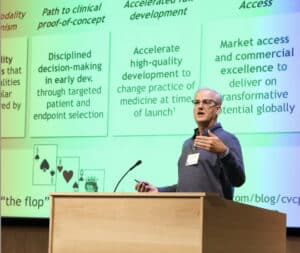
If you’ve followed this blog for a while, you’ll know I often say drug discovery is more like poker than chess (see here and here). You are also likely familiar with our end-to-end R&D principles at Bristol Myers Squibb – our belief that if we select the right targets based on human biology, match the right kind of medicine to the biological mechanism of disease, and provide early evidence that an idea is working, we can increase the probability of success and accelerate the pace of delivering transformational medicines to more patients.
Recently, I built out my poker analogy more thoroughly in a presentation at the Broad Institute’s Variant to Function (V2F) Symposium. Using specific examples within the BMS portfolio, I demonstrated the connection between poker and our R&D principles, highlighting assets at different stages of play. You can view the full presentation here.
The crux of my thesis is this: strong causal human biology, paired with the right modality for the mechanism of action, gives you a great starting hand – much like being dealt a queen and an ace in a round of Texas Hold ‘em poker. But a great starting hand isn’t always a winning hand. The odds of a winning hand are influenced by the community cards presented by the dealer: the flop, the turn and the river.
As I have argued before, the flop is the where the odds change the most – and this aligns with proof of concept in drug discovery. The turn and the river also influence the outcome of a player’s hand, just as our ability to accelerate full development and maximize market access impact our ability to deliver meaningful medicines to patients.
Importantly, in drug discovery, the more data we have to inform each stage of play, the more confidently we can play our hand. At V2F, I shared how our partnership with Octant allowed us to use deep mutational scans (DMS) to reveal therapeutic insights about TYK2 signaling and disease (you can read a preprint publication of this work here). This sort of technology can build confidence in target selection and, potentially in the future, could help identify more novel targets.
I concluded my talk with a question for the audience: what should be done next? How do we continue identifying novel targets that give us a strong “hand”? Can we scale saturation mutagenesis across more of the proteome, or are computational methods now robust enough to replace some functional studies? These open questions will shape how we build confidence in our drug discovery “poker hands” – and ultimately, how we place winning billion-dollar bets that deliver transformational medicines to patients.

